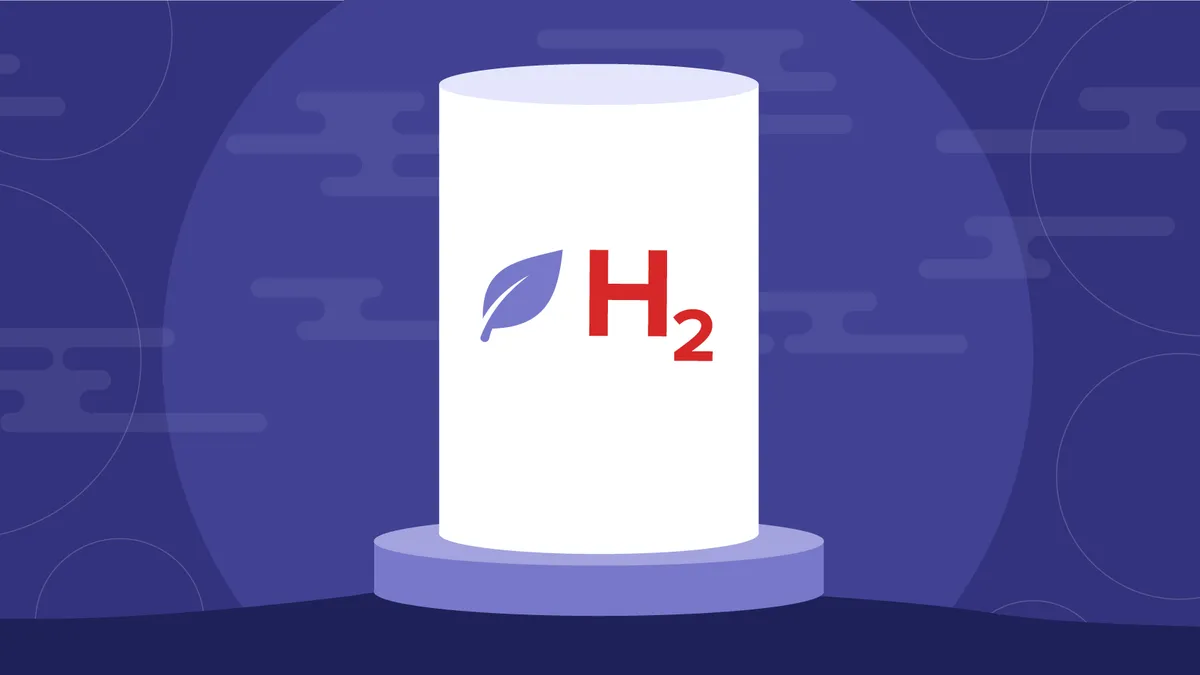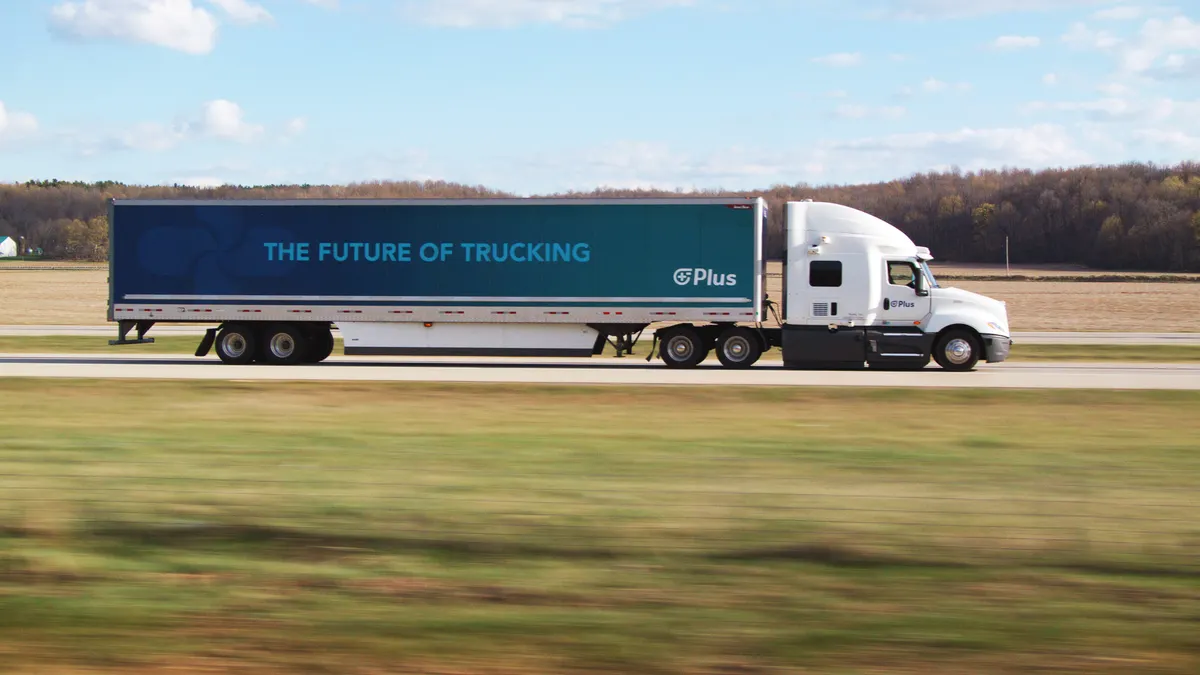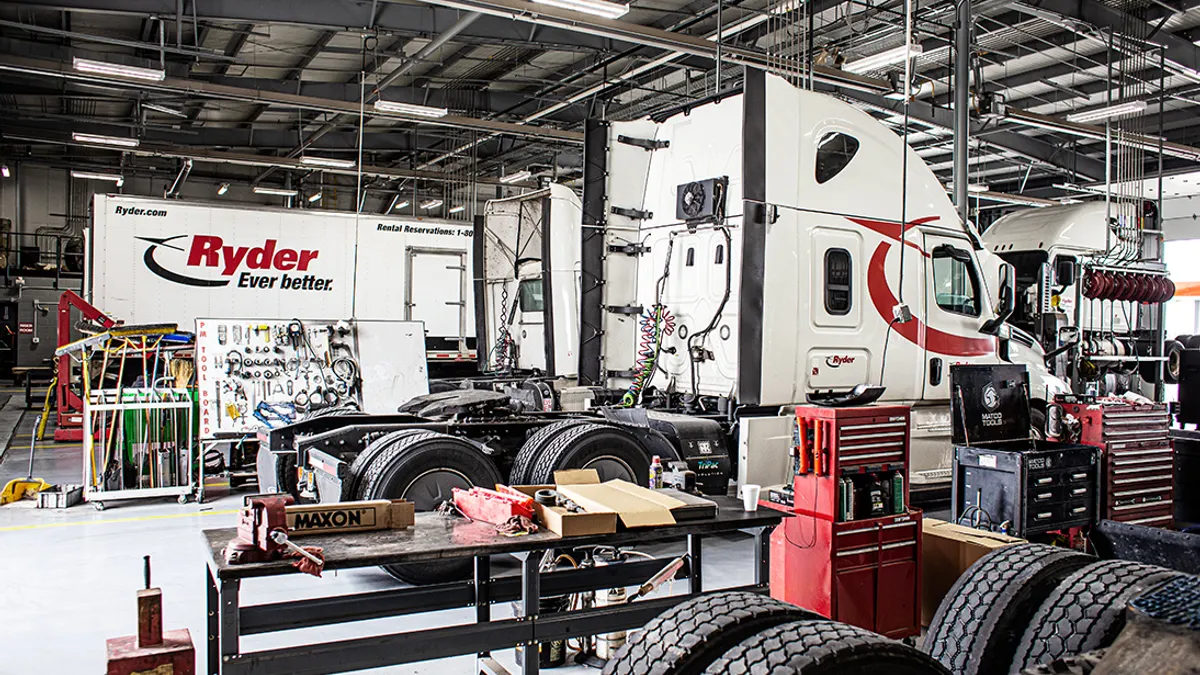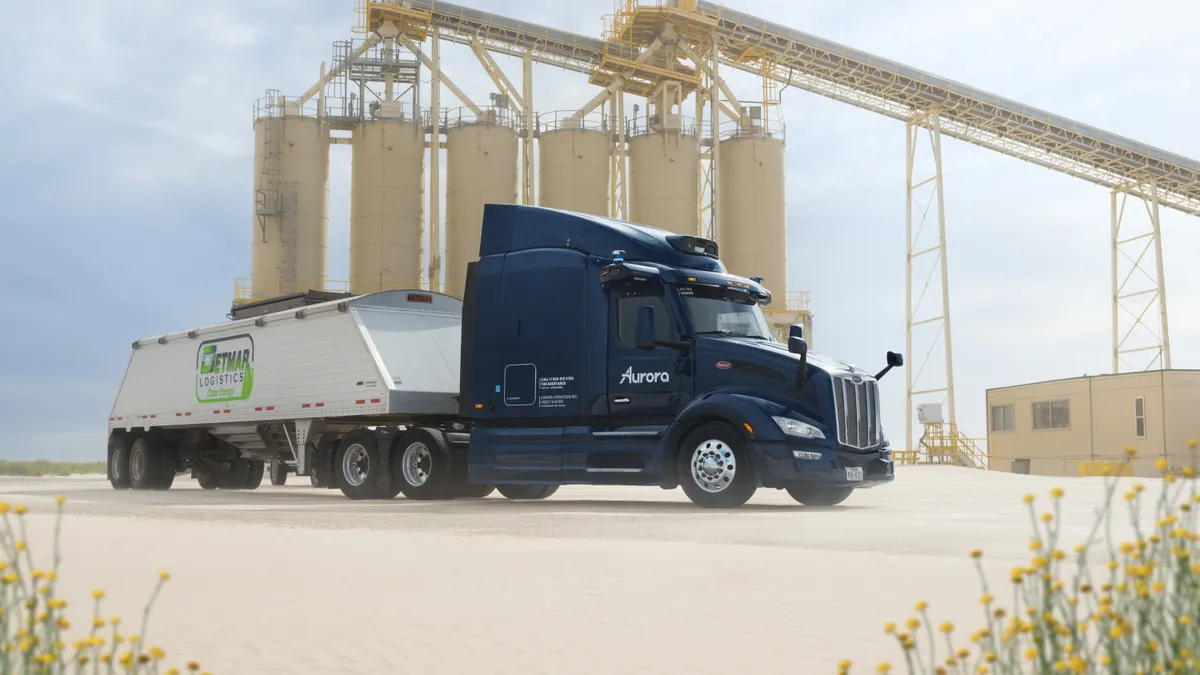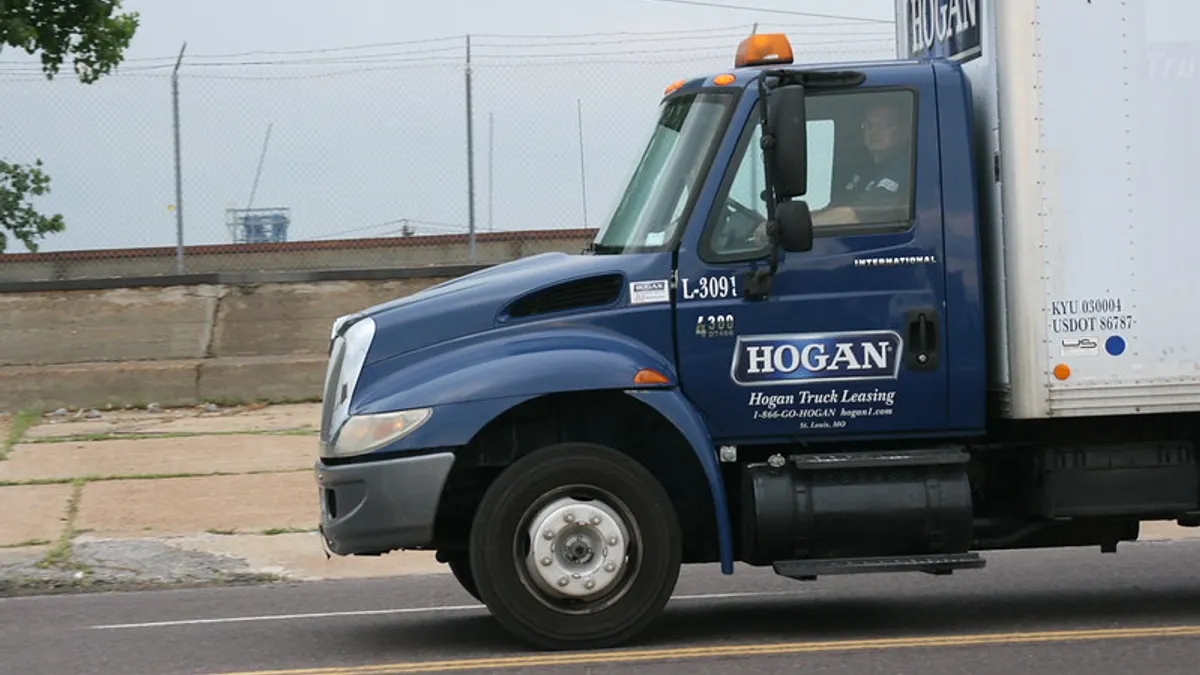Renewables-generated electricity and battery energy storage can eliminate most power system greenhouse gas emissions, especially in the near term.
But fueling heavy-duty vehicles, serving the unique needs of other industries and storing large amounts of energy for long durations are major challenges electricity cannot readily meet. Hydrogen extracted from water with renewables-generated electricity by an electrolyzer could be the best GHG-free alternative, analysts told Transport Dive sister publication Utility Dive.
"The best way of doing long duration, massive volume storage is by transforming electrons into molecules with an electrolyzer," ITM Power CEO Graham Cooley, who is building the world’s first GW-scale electrolyzer plant, told Utility Dive. "Green hydrogen molecules can replace the fossil-generated hydrogen used today."
GHG reduction mandates have driven renewables costs to unanticipated lows and are starting to do the same for electrolyzers, stakeholders, utility executives and advocates told Utility Dive. Green hydrogen is forecast to be cost-competitive by 2030 or sooner, and utilities and heavy-duty vehicle fleet owners are developing pilots across a range of applications.
The question is whether transforming renewable electrons to zero GHG hydrogen molecules is a necessary and cost-effective alternative to generating electricity with renewables and electrifying everything.
Renewables, electrolyzers and hydrogen
Electricity production creates 26.9% of U.S. GHGs, according to the most recent (2018) Environmental Protection Agency data. But GHGs from transportation (28.2%), industry (22%) and buildings (12.3%) are more than double that.
Hydrogen can replace fossil fuels to address GHGs in generation and non-power production uses, if it is green hydrogen made with zero-GHG electricity. But that's "less than 1% of all hydrogen production," according to Wood Mackenzie’s October 2019 report on green hydrogen.
"The 10 million tons of hydrogen produced annually in the U.S., mostly with natural gas, can be replaced with green hydrogen because, like natural gas, it can be ramped, stored and delivered on demand."

Ken Dragoon
Executive Director at Renewable Hydrogen Alliance
With mandates for renewables driving excess wind, solar and hydropower production in more states, policymakers and stakeholders are already starting to see storage of green hydrogen as a two-way solution for reducing emissions in energy and industrial applications. It can help meet GHG reduction goals and address the problematic curtailments and depressed power prices that can arise due to overproduction of renewables.
Demand growth could make green hydrogen "cost-competitive in select markets by 2030" in its full range of applications, the WoodMac report said. And it should be a cost-competitive source of long duration storage by mid-century, according to a May National Renewable Energy Laboratory study.
In Europe, renewables over-generation is "already driving economies of scale in electrolyzer manufacturing" that are "driving down electrolyzer capital costs," said Renewable Hydrogen Alliance Executive Director Ken Dragoon. "The 10 million tons of hydrogen produced annually in the U.S., mostly with natural gas, can be replaced with green hydrogen because, like natural gas, it can be ramped, stored and delivered on demand."
Economic sectors —such as chemical and industrial manufacturing, air travel, ocean shipping, and long-distance, heavy-duty transport — will likely require some synthetic fuel, such as green hydrogen, to eliminate GHGs, Dragoon said. And green hydrogen may be the most affordable and flexible long-duration storage option for any of those applications, he added.
Alkaline and polymer electrolyte membrane, or PEM, electrolyzers are the two main ways to produce green hydrogen. Both can use renewables-generated electricity to convert water to hydrogen for chemical or energy applications. Traditional alkaline production is more affordable but less durable, ITM Power’s Cooley said. PEM production, used since the 1950s, is "emerging" in the market because of its flexibility and smaller footprint.
ITM has contracted for "over $50 million in green hydrogen projects in the last 12 months" and has "bids pending for $263 million more, which shows how quickly the market is moving" in response to the steadily improving economics, Cooley added.
Multi-GW electrolyzer commitments in Europe will likely drive electrolyzer prices to "less than $500/kW by the mid-2020s, with a 50% load factor," which is likely to interest U.S. developers, Cooley said.
Studies show each doubling of installed electrolyzer capacity brings the cost down about 20%, Dominion Energy New Gases Business Development Manager Andrew Hegewald told Utility Dive. For green hydrogen to scale, today’s U.S. price would need to be reduced about 50% to $600/kW to $900/kW, which is more likely by 2030, he added.
With the level of interest accelerating, electrolyzer prices could fall even faster, said Steve Szymanski, director of business development, projects and government for global electrolyzer manufacturing leader Nel. "The U.S. market could drive enough demand to bring the cost down by the mid-2020s, but most applications are still very much pre-commercial and most projects being built today are at pilot scale and require incentives."
In the real world
The most ambitious green hydrogen application now being developed is northwestern Utah’s Intermountain Power Project. The existing 1,800 MW coal facility will be replaced with a two-unit 840 MW combined cycle natural gas plant capable of burning a 30% green hydrogen-70% natural gas blend by 2025.
It will be owned by the Intermountain Power Agency, a consortium of 23 Utah municipal utilities, and operated by the Los Angeles Department of Water and Power. Through the existing 2,400 MW high voltage direct-current transmission line that now serves the coal facility, the Los Angeles department will be project's biggest off-taker, but it will also serve other California and Utah municipalities.
The power agency issued a "multi-stage" solicitation on June 23 for offers to supply green H2 to IPP beginning in the fourth quarter of 2024, Los Angeles Department of Water and Power spokesperson Carol Tucker emailed Utility Dive.
The department has also contracted with Mitsubishi Hitachi Power Systems for two power trains for the Intermountain Power Project. They are "the first Advanced Class Gas Turbines in the industry specifically designed and purchased as part of a comprehensive plan to sequentially transition from coal, to natural gas, and finally to renewable H2 fuel," the department reported.
The contract guarantees they will be modified for "100% renewable hydrogen by 2045, to meet the Los Angeles zero-emissions mandate," the department's operating agent for the project, Gregory Huynh,told Utility Dive in March.
The Intermountain Power Project has a secure water supply and will interconnect with large existing and potential wind, geothermal, hydropower and solar supplies for onsite green hydrogen electrolysis, Huynh said. And, in May 2019, Mitsubishi Hitachi Power Systems announced the Advanced Clean Energy Storage project, which would store green hydrogen in an underground salt dome at the site for on-demand dispatch.
As a first of its kind project, the "economics remain to be seen" and "could be quite expensive," Huynh acknowledged. But with electrolyzer and renewable energy costs coming down, the Los Angeles Department of Water and Power sees the Intermountain Power Project as a significant step toward making green hydrogen cost-competitive and has had "preliminary discussions on the feasibility" of producing or using green hydrogen at its other natural gas plants.
Other projects do not match the intermountain project's scale, but do demonstrate the green hydrogen market is gaining momentum.
Pending regulatory approval, NextEra Energy will build a pilot 20 MW electrolyzer to turn excess solar generation into green hydrogen for use by subsidiary Florida Power and Light, the company revealed July 24. The green hydrogen will be delivered to the utility's 1.75 GW Okeechobee natural gas plant to reduce the plant's emissions.
Washington state’s Douglas County Public Utility District recently purchased a 5 MW PEM electrolyzer for operation by late 2021, the utility’s Public Information Officer Meaghan Vibbert told Utility Dive. The pilot will test use cases for excess hydro generation stored as green hydrogen, she said.
Tacoma Power is planning a different application for its abundant, low cost hydropower, said the utility's Manager of Energy Research and Development Cam LeHouillier. It will be converted to green hydrogen, stored and trucked in liquid form to meet local fuel and industrial needs, he said.
California’s Stone Edge Farm Estates' alkaline electrolyzer so successfully turned its 200 kW solar array’s excess into green hydrogen that it is upgrading, Heila Technologies microgrid engineer Jorge Elizondo told Utility Dive. The new, 10-times-larger PEM electrolyzer, with the site's solar and 800 kWh of short duration battery storage, is expected to provide 10 MWh of stored summer solar "to meet winter load," Elizondo said.
One of the most ambitious transportation sector applications is SunLine Transit Agency’s 16-bus hydrogen fleet, now in operation for about six months, Nel’s Szymanski said. Nel's 2 MW electrolyzer and supporting hardware create hydrogen at SunLine’s Thousand Palms, California, site, he said. "If it was trucked, it would be four times more expensive."
California’s grid electricity makes SunLine’s fleet "24% green," Sunline CEO/General Manager Lauren Skiver emailed Utility Dive. But the company plans to convert all its vehicles to zero-GHGs by 2035 and is building a dedicated 4 MW solar array with battery storage to make it "a green product from well to wheel," she added.
"We plan to utilize our microgrid to generate renewable hydrogen," she said. That will allow "operation of the 2 MW green hydrogen fueling station, storage of the additional hydrogen, and future scaling up."
SunLine’s goal is to produce green hydrogen at under $5/kg, she said. With adequate volumes, SunLine could fuel other fleets’ hydrogen vehicles, serve battery-electric vehicle charging stations, or supply a hydrogen fueling station on the adjacent interstate highway, she added.
"We need more hydrogen and we need more solutions," Skiver said. When affordable fueling is available at their sites, "more fleet operators will move to hydrogen."
Nikola Motor's recent NASDAQ splash was driven largely by excitement over its $30 million-plus purchase of 85 MW of Nel alkaline electrolyzer capacity, market analysts reported. They will supply five planned Nikola heavy-duty vehicle fueling stations covering "multiple states and trucking routes," Founder/CEO Trevor Milton said in the company’s statement.
The plan is to provide seven-year or 700,000-mile leases for hydrogen-powered heavy-duty vehicles, hydrogen fuel, and fueling stations to access it, by 2023, Nikola VP of Business Development and Defense Andrew Christian told Utility Dive in an email. The company forecasts the leases will reduce the total cost of ownership by $0.02/mile.
"A natural gas line would have to be reconditioned [to transport hydrogen], which is expensive but more cost-effective than building a new green hydrogen pipeline because existing lines have easements and infrastructure in place."

Andrew Hegewald
New Gases Business Development Manager at Dominion Energy
Two utility industry leaders are considering green hydrogen in transportation applications.
Sacramento Municipal Utility District is in discussions with Sacramento’s Air Quality Management District about providing a substation and a heavy-duty vehicle hydrogen fueling pilot electricity rate for participating fleet users, the Air District's Executive Director and Air Pollution Control Officer Alberto Ayala told Utility Dive. "The right cost point for electricity is necessary for pilots to be viable."
Dominion Energy sees green hydrogen's potential in transportation and many other applications.
Green hydrogen can be "a tool in our decarbonization toolkit where state policies support it," Dominion’s Hegewald said. Eventually, there could be "an ecosystem of off-takers" connected by a distribution pipeline, he added. "There might be a steel mill, fueling stations, an ammonia plant and others using both the fuel and the chemical that together offset the financial risk" of building a pipeline.
An electrolyzer at a renewables project with a water source would make green hydrogen and "a trunk pipeline would be built to take it to a population center," he said. "Spurs from the trunk line would run to end users or to where hydrogen could be trucked the last few miles to users that could afford the extra cost."
That raises the biggest question about green hydrogen after its cost curve, which is how it will be delivered.
The delivery challenge
There is debate about delivery in existing natural gas pipelines.
Green hydrogen blends above 10% to 20% can make existing pipelines brittle and subject to leakage, Dominion’s Hegewald said. "A natural gas line would have to be reconditioned, which is expensive but more cost-effective than building a new green hydrogen pipeline because existing lines have easements and infrastructure in place."
Other options would be generating and storing green hydrogen at renewables projects and feeding the electricity produced by the project into the transmission system, or using the SunLine plan, or, especially for chemical processes, liquefying and trucking it, he added.
"With electrons to molecules, green hydrogen can be liquefied and trucked or shipped in bulk for long duration storage, transportation, and industrial applications, making hydrogen the bridge between economic silos."

Steve Szymanski
Director of Business Development at Nel
Today’s excess renewables and existing pipelines can deliver blends to grow the market and lead to new dedicated renewables projects for green hydrogen production, Nel’s Szymanski said. "But green hydrogen is not likely to scale without having the kind of pipeline system that has made natural gas so cheap and broadly distributed."
At very high volumes of green hydrogen, there would need to be a new or retrofitted economy-wide pipeline system, but it would take "a massive penetration of green hydrogen to justify that cost," Dominion’s Hegewald said. If it happens, "it is a long way off and will likely only work after policy support drives the cost of green hydrogen down."
Some policy support is already in place.
California’s economy-wide zero GHGs by 2045 mandate and its newly enacted mandate for half of heavy duty vehicles sold in the state to be zero emission by 2035 make "pipeline green hydrogen a real possibility," SunLine’s Skiver said. And existing natural gas pipeline and storage facilities may be a way to meet those policy mandates, she agreed.
The future will likely be "a combination of technologies distributing green hydrogen," Szymanski said. "With electrons to molecules, green hydrogen can be liquefied and trucked or shipped in bulk for long duration storage, transportation, and industrial applications, making hydrogen the bridge between economic silos."


